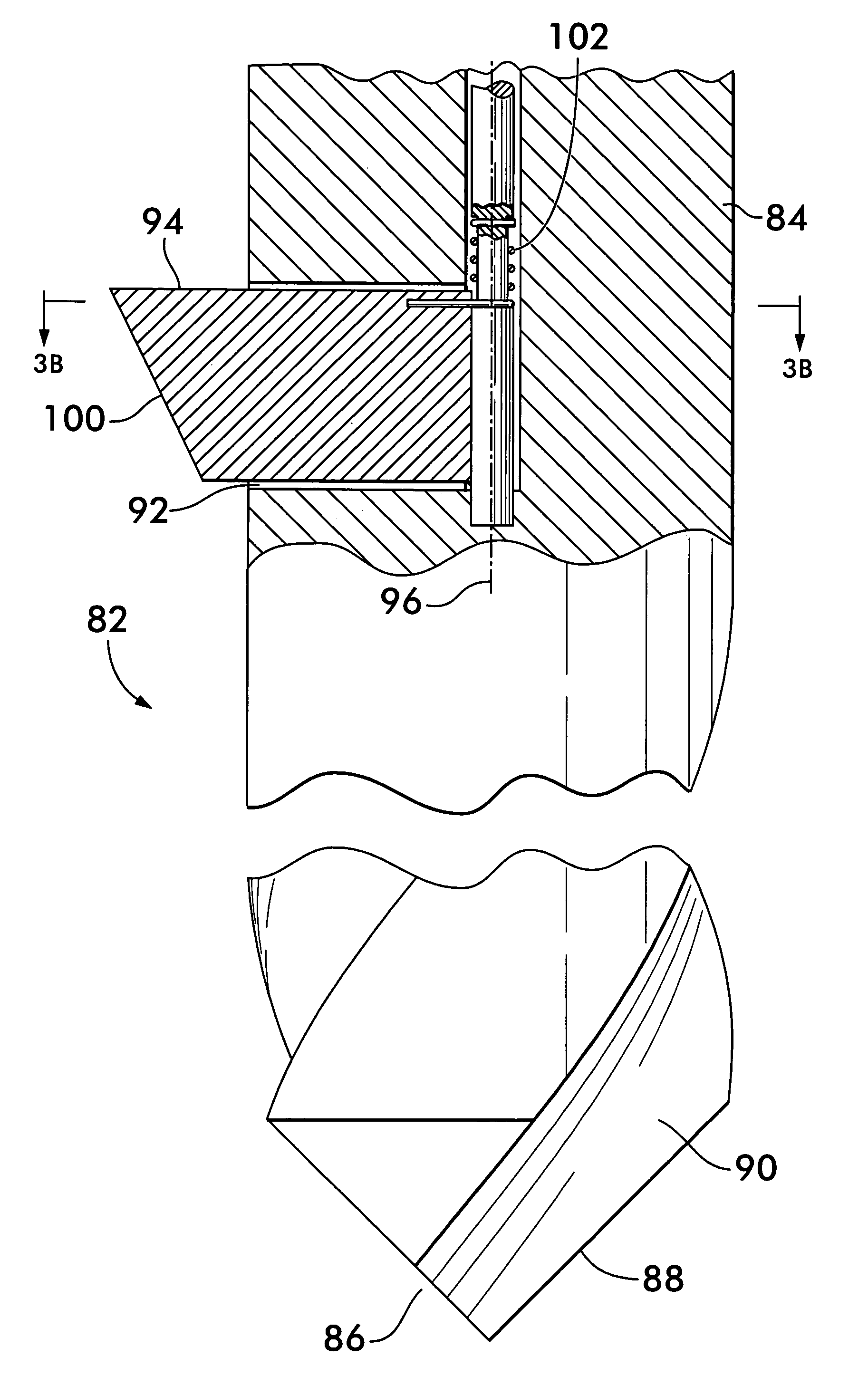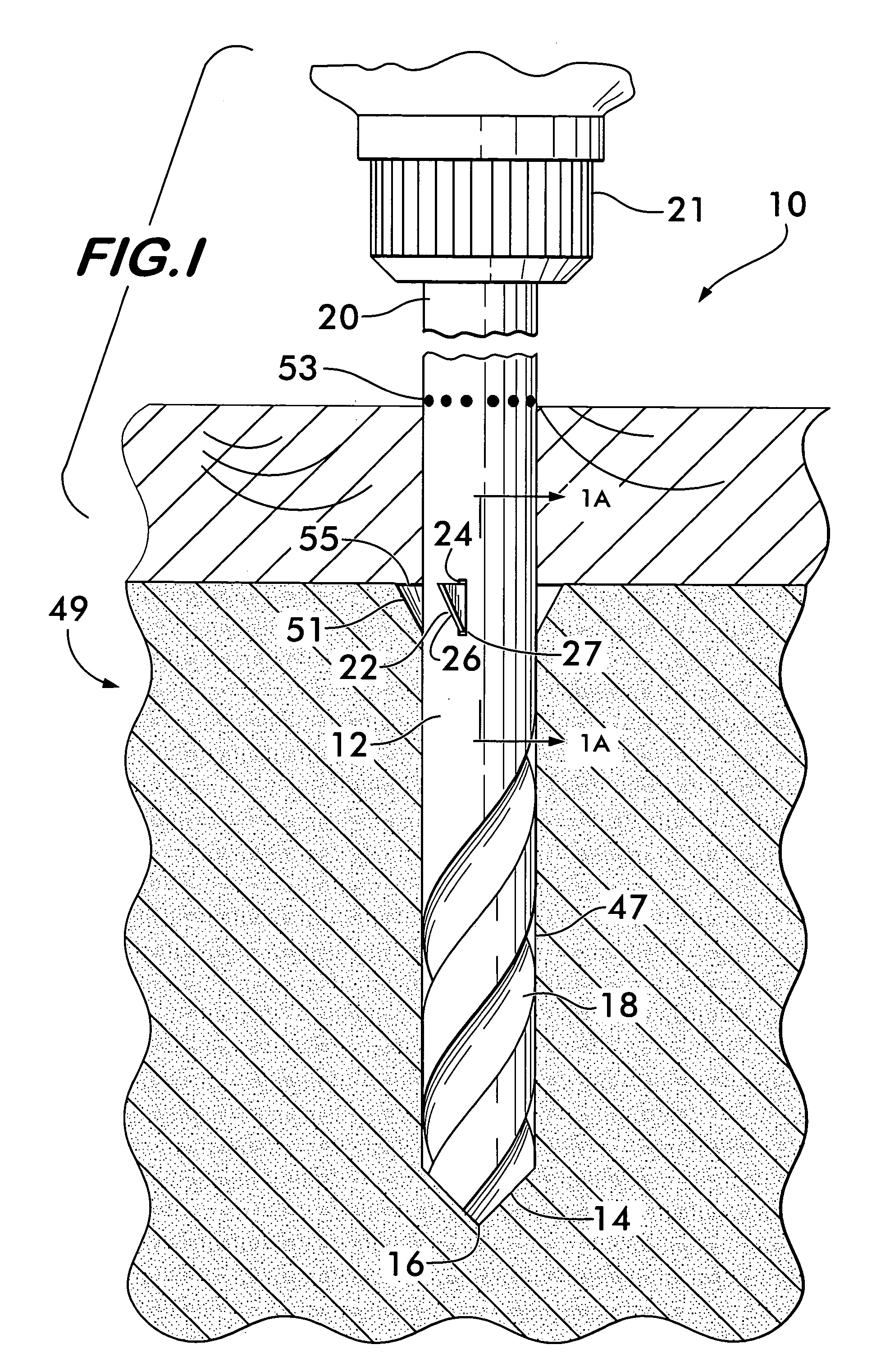Tool with deployable cutting blade
a cutting blade and tool technology, applied in the field of tools, can solve the problems of increasing the stress of the substrate, reducing the service life of the tool,
- Summary
- Abstract
- Description
- Claims
- Application Information
AI Technical Summary
Benefits of technology
Problems solved by technology
Method used
Image
Examples
embodiment 10
[0023]FIG. 1 shows an embodiment 10 of a tool with a deployable cutting blade for making an undercut according to the invention. Tool 10 comprises an elongated bit shaft 12 having opposed angularly oriented cutting edges 14 arranged at a cutting tip 16. Helical grooves 18 extend longitudinally along the bit shaft 12 to facilitate removal of cutting debris generated by the cutting edges 14. A tang 20 is positioned at the opposite end of the bit shaft 12. The tang is preferably cylindrical but may have other shapes compatible with a particular chuck 21 in order to prevent slippage of the bit relative to the chuck during drilling.
[0024]A cutting blade 22 is slidably positioned within a slot 24 positioned within the bit shaft 12 in spaced relation to the cutting tip 16. As shown by arrow 23 in FIG. 1A, blade 22 is movable radially relatively to the bit shaft 12 within the slot 24 between a retracted position, shown in solid line with the blade 22 located within a chamber 25 in the bit s...
embodiment 50
[0030]FIGS. 2A and 2B show another embodiment 50 of a tool with a deployable cutting blade according to the invention. Tool 50 has a bit shaft 52 with angled cutting edges 54 at its cutting end 56 and a tang (not shown) at its opposite end. Helical grooves 58 extend along the surface 60 of the bit shaft. A longitudinal bore 62 is positioned, preferably coaxially, within bit shaft 52. Bore 62 is in communication with a chamber comprising a passageway 64 oriented at an angle 66 relatively to the bore 62. Passageway 64 leads to an opening 67 in the surface 60 of the bit shaft 52, the opening 67 being in spaced relation to cutting edges 54. Passageway 64 comprises an upper guide surface 68 and a lower guide surface 70. The guide surfaces are preferably curved for reasons described below.
[0031]A cutting blade 72 is moveably positioned within passageway 64. Blade 72 comprises a flexible and resilient blade shaft 74 which is deflected into a curved shape as it engages the guide surfaces 68...
embodiment 104
[0037]FIGS. 4A and 4B illustrate another embodiment 104 of a tool according to the invention. Again, tool 104 has a bit shaft 106 comprising a cutting end with angled cutting edges 108 and a tang (not shown) at the opposite end for engaging a chuck of a drill. Helical grooves 112 extend along the bit shaft 106 for debris removal during drilling.
[0038]A longitudinal bore 114 extends from the tang along bit shaft 106, preferably coaxial therewith. The bore 114 is adapted to receive a passageway 115 conveying pressurized fluid, preferably supplied through a coupling (not shown) at the tang. The coupling is designed to pass the hydraulic fluid from a stationary source to the passageway 115 which rotates with the bit 104 during drilling.
[0039]A chamber 116 is positioned in the bit shaft 106 in spaced relation to the cutting edges 108. A cutting blade 118 is pivotally mounted within the chamber 116 and rotates about a pivot axle 120 oriented transversely to the bit shaft 106. Blade 118 ro...
PUM
| Property | Measurement | Unit |
|---|---|---|
| length | aaaaa | aaaaa |
| rotation | aaaaa | aaaaa |
| dimensions | aaaaa | aaaaa |
Abstract
Description
Claims
Application Information
 Login to View More
Login to View More - R&D
- Intellectual Property
- Life Sciences
- Materials
- Tech Scout
- Unparalleled Data Quality
- Higher Quality Content
- 60% Fewer Hallucinations
Browse by: Latest US Patents, China's latest patents, Technical Efficacy Thesaurus, Application Domain, Technology Topic, Popular Technical Reports.
© 2025 PatSnap. All rights reserved.Legal|Privacy policy|Modern Slavery Act Transparency Statement|Sitemap|About US| Contact US: help@patsnap.com



